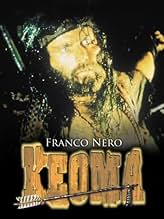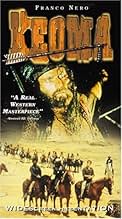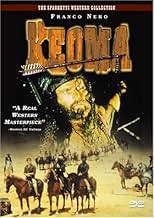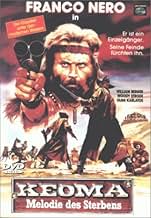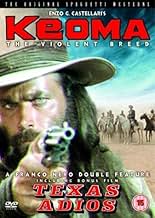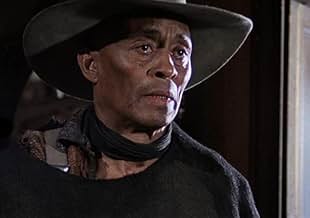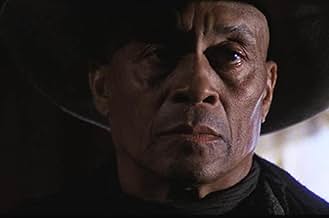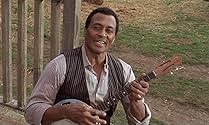PUNTUACIÓN EN IMDb
7,0/10
6,6 mil
TU PUNTUACIÓN
Un ex pistolero de la Unión intenta proteger su ciudad natal de ser anulada por sus medios hermanos racistas y un tirano confederado.Un ex pistolero de la Unión intenta proteger su ciudad natal de ser anulada por sus medios hermanos racistas y un tirano confederado.Un ex pistolero de la Unión intenta proteger su ciudad natal de ser anulada por sus medios hermanos racistas y un tirano confederado.
- Dirección
- Guión
- Reparto principal
Joshua Sinclair
- Sam Shannon
- (as John Loffredo)
Donald O'Brien
- Caldwell
- (as Donald O'Brian)
Leonardo Scavino
- Doctor
- (as Leon Lenoir)
Antonio Basile
- Caldwell's Henchman
- (sin acreditar)
Giovanni Bonadonna
- Caldwell's Henchman
- (sin acreditar)
Armando Bottin
- Caldwell's Henchman
- (sin acreditar)
Aldo Canti
- Wagon Fugitive
- (sin acreditar)
- …
Felice Ceciarelli
- Caldwell's Henchman
- (sin acreditar)
Reseñas destacadas
This film has so much that works so well, it's a shame one thing keeps it from working entirely l: the music. The single most annoying song I've ever heard in a film. Secondly the newest "restored" version inexplicably has two totally different English voices dubbed for Nero. His first few lines are delivered in a deep clear "radio announcer" pure English baritone, the rest of the film is in a poorly faked accent. What exactly would be the reason for this? Other than those two distractions, a great late era entry to the genre.
Director Castellari is nowadays perhaps best-known (if at all) by the younger generation of film buffs for one thing: making the original INGLORIOUS BASTARDS (1977), which Quentin Tarantino has been threatening to remake for years now. However, in my opinion, he should instead be remembered for making this impressive, belated Spaghetti Western gem.
An odd blend of violent action and heady mysticism apparently concocted by one of the credited screenwriters Luigi Montefiori (better known to hardened Euro-Cult fans as an actor under the alias of George Eastman) but, as star Franco Nero and Castellari himself state in the Anchor Bay DVD supplements, the script took so long to get written that they decided to work without one and make the dialogue up as they went along! That the end result is so satisfying (and practically unique in the subgenre) is a remarkable achievement in itself.
Keoma is a half-breed returning home from the American Civil War to find his hometown ravaged by the plague and overtaken by the villainous Caldwell (Donal O' Brien); among his cohorts are Nero's three half-brothers who had made his childhood a living hell, with his surrogate father (William Berger) and colored mentor turned banjo-playing town-drunk (Woody Strode) unable to do much to counter Caldwell's oppression. A Bergmanesque, cadaverous old woman is frequently seen roaming the streets dragging a cart behind her...
What follows is the typical confrontation between Good and Evil but Castellari infuses the familiar mixture with several directorial flourishes: occasionally striking compositions (particularly a memorably Fordian opening shot), frequent use of slow-motion in true Peckinpah-style, flashbacks in which Keoma is a spectator to his own past experiences (inspired by Elia Kazan's THE ARRANGEMENT [1969]!), a touch of elliptical editing, Christian symbolism (Keoma is crucified at one point) and, most distressingly of all, a folksy soundtrack (inspired by Leonard Cohen and Bob Dylan, no less and warbled...er...sung by a shrill, high-pitched female singer and an out-of-tune deep-voiced male) which narrates in song the action we're seeing on the screen. I say distressingly because the Guido and Maurizo De Angelis compositions found here have forever been a thorn in the side of even the film's staunchest admirers!! Personally, I didn't mind the female singer so much after a while but when her (possibly drunk) male companion took over in the last half hour, I was in for some cringe-inducing moments for sure...!
Despite these misgivings, the film is still one of the best Spaghetti Westerns out there (and certainly the last great example of the subgenre); its undoubted highlight is provided by a terrific, lovingly protracted action set-piece in which Nero, Berger and a reformed Strode (back to his former arrow-shooting glory - perhaps a nod to the role he played in Richard Brooks' splendid THE PROFESSIONALS [1966]) wipe out most of Caldwell's gang. Their triumph is short-lived, however, because both Berger and Strode lose their lives in the ongoing struggle (Berger poignantly so, while Strode's death scene is particularly great), with Nero almost bowing out himself under the strain of his siblings' torture - who have subsequently disposed of Caldwell and taken over the town themselves; the final confrontation, then, between Keoma and his three half-brothers is eerily set to the "strains" of Olga Karlatos' (playing a woman Keoma had earlier on saved from a plague-infested colony) wailing and screaming as she lies giving birth to a child amidst the carnage!
While at first I was disappointed that the Anchor Bay DVD only included the English dub, having watched it now it seems clear that the actors were all speaking their dialogue in English on the set - although, as connoisseurs will certainly know, this was all re-recorded back in the studios anyway (as was common practice in the Italian film industry). Still, if ever it gets shown again on Italian TV, I'll be sure to check it out just for completeness' sake. Thankfully, however, Castellari contributes a highly enthusiastic and informative Audio Commentary in which he discusses his major influences while making the film, among them Sidney J. Furie's THE APPALOOSA (1966), Altman's McCABE AND MRS. MILLER (1971) and Peckinpah's PAT GARRETT AND BILLY THE KID (1973).
Ultimately, Franco Nero in the title role is almost as iconic a figure as Django and, hopefully, I should be getting to another fairly obscure but highly intriguing Spaghetti Westen of his - Luigi Bazzoni's MAN, PRIDE AND VENGEANCE (1968), an eccentric updating of Georges Bizet's opera "Carmen", co-starring Klaus Kinski and Tina Aumont - pretty soon...
An odd blend of violent action and heady mysticism apparently concocted by one of the credited screenwriters Luigi Montefiori (better known to hardened Euro-Cult fans as an actor under the alias of George Eastman) but, as star Franco Nero and Castellari himself state in the Anchor Bay DVD supplements, the script took so long to get written that they decided to work without one and make the dialogue up as they went along! That the end result is so satisfying (and practically unique in the subgenre) is a remarkable achievement in itself.
Keoma is a half-breed returning home from the American Civil War to find his hometown ravaged by the plague and overtaken by the villainous Caldwell (Donal O' Brien); among his cohorts are Nero's three half-brothers who had made his childhood a living hell, with his surrogate father (William Berger) and colored mentor turned banjo-playing town-drunk (Woody Strode) unable to do much to counter Caldwell's oppression. A Bergmanesque, cadaverous old woman is frequently seen roaming the streets dragging a cart behind her...
What follows is the typical confrontation between Good and Evil but Castellari infuses the familiar mixture with several directorial flourishes: occasionally striking compositions (particularly a memorably Fordian opening shot), frequent use of slow-motion in true Peckinpah-style, flashbacks in which Keoma is a spectator to his own past experiences (inspired by Elia Kazan's THE ARRANGEMENT [1969]!), a touch of elliptical editing, Christian symbolism (Keoma is crucified at one point) and, most distressingly of all, a folksy soundtrack (inspired by Leonard Cohen and Bob Dylan, no less and warbled...er...sung by a shrill, high-pitched female singer and an out-of-tune deep-voiced male) which narrates in song the action we're seeing on the screen. I say distressingly because the Guido and Maurizo De Angelis compositions found here have forever been a thorn in the side of even the film's staunchest admirers!! Personally, I didn't mind the female singer so much after a while but when her (possibly drunk) male companion took over in the last half hour, I was in for some cringe-inducing moments for sure...!
Despite these misgivings, the film is still one of the best Spaghetti Westerns out there (and certainly the last great example of the subgenre); its undoubted highlight is provided by a terrific, lovingly protracted action set-piece in which Nero, Berger and a reformed Strode (back to his former arrow-shooting glory - perhaps a nod to the role he played in Richard Brooks' splendid THE PROFESSIONALS [1966]) wipe out most of Caldwell's gang. Their triumph is short-lived, however, because both Berger and Strode lose their lives in the ongoing struggle (Berger poignantly so, while Strode's death scene is particularly great), with Nero almost bowing out himself under the strain of his siblings' torture - who have subsequently disposed of Caldwell and taken over the town themselves; the final confrontation, then, between Keoma and his three half-brothers is eerily set to the "strains" of Olga Karlatos' (playing a woman Keoma had earlier on saved from a plague-infested colony) wailing and screaming as she lies giving birth to a child amidst the carnage!
While at first I was disappointed that the Anchor Bay DVD only included the English dub, having watched it now it seems clear that the actors were all speaking their dialogue in English on the set - although, as connoisseurs will certainly know, this was all re-recorded back in the studios anyway (as was common practice in the Italian film industry). Still, if ever it gets shown again on Italian TV, I'll be sure to check it out just for completeness' sake. Thankfully, however, Castellari contributes a highly enthusiastic and informative Audio Commentary in which he discusses his major influences while making the film, among them Sidney J. Furie's THE APPALOOSA (1966), Altman's McCABE AND MRS. MILLER (1971) and Peckinpah's PAT GARRETT AND BILLY THE KID (1973).
Ultimately, Franco Nero in the title role is almost as iconic a figure as Django and, hopefully, I should be getting to another fairly obscure but highly intriguing Spaghetti Westen of his - Luigi Bazzoni's MAN, PRIDE AND VENGEANCE (1968), an eccentric updating of Georges Bizet's opera "Carmen", co-starring Klaus Kinski and Tina Aumont - pretty soon...
Review of English-language Blue Underground version:
My, my these Spaghettis. In Keoma (Franco Nero), we have a man who has descended into hell, he has become an annihilator. The landscape is infernal, from the Breughelesque sets to the leering henchman to the blasted mountains. For his enemies, he has two barrels of a shotgun, and no pity. The hell is as much in his mind as it is in the town he rides into. He is a man with no place, ideology or purpose. Unlike Eastwood's characters in the dollars trilogy who are without history or neuroses, with Nero as Keoma we have a profound psychological portrait of a man in spiritual agony, on the road to obliteration and self-immolation.
The scenario is also hellish, we have a town and a region that has been taken over by a warlord. He and his henchman block access from and to the outside world. The townsfolk are all infected with a plague, and rather than given access to medical aid, they are put in a concentration camp and forced to mine for silver, or simply murdered. The town is left to the henchmen and their trollops. This for me is very unlike a western in the traditional American sense. In the American western, there are always the upright people of the town to appeal to, there is a sheriff, or as a last resort the cavalry. People may be run off their land or be claim-jumped, but they are never forced into slave labour.
What we have in Keoma, and in similar movies such as Django and Django Strikes Again, is a fundamentally African western, which is probably why Spaghetti goes down so well on that continent. The town in Keoma is more reminiscent of somewhere in Sierra Leone than the Sierra Nevada. There is total brutal oppression of the populace. There is a reckless attitude towards the value of life. Keoma is likewise a more fitting hero for such a landscape, he is almost a Christ-like figure in the sense that he is betrayed or deserted by everyone in this movie, his family, the oppressed, and the liberated. When Keoma is crucified on a wagonwheel the artisans, politicos, henchmen and whores celebrate a change of leadership in the saloon that was entirely down to him. He is constantly grimy, his hair is totally overgrown, he is hirsute, sweaty, and wears no overshirt. Seeing him shove his pistol down the back of his trousers against his bare back will make the ladies a little queasy.
This movie has a very dreamlike atmosphere. The reason for this is that there is no real cohesive plot. Apparently Castellari threw the script in the bin immediately prior to shooting and adopted a completely improvisational approach. The only consistency to the movie is that of image and emotion. Throughout the movie is laced with the anguish of haunted souls, and punctuated by the slow-mo killings after the fashion of Peckinpah. The improvisation can unfortunately be quite clear. Some of the actors were writing their own lines the night before shooting. The dialogue is not always brilliant to say the least, and it is not helped by Nero's far from accent-less English. However this is about the only film where improvisation could work, simply because it is entirely beneficial to the oneiric, logic-less atmosphere.
The De Angelis brothers' soundtrack will be interesting to some because of the untrained voices. Nero sings quite a lot of it himself, and you will have to suspend disbelief and accept it, because although the man clearly has no singing talent, there is an authenticity to his singing that is refreshing.
I'm not sure what Woody Strode was doing in this picture, but flashbacks of him shooting his bow add to the trippiness. Keoma the movie is not quite as far-out as something by Jodorowsky, but it's on the way.
My, my these Spaghettis. In Keoma (Franco Nero), we have a man who has descended into hell, he has become an annihilator. The landscape is infernal, from the Breughelesque sets to the leering henchman to the blasted mountains. For his enemies, he has two barrels of a shotgun, and no pity. The hell is as much in his mind as it is in the town he rides into. He is a man with no place, ideology or purpose. Unlike Eastwood's characters in the dollars trilogy who are without history or neuroses, with Nero as Keoma we have a profound psychological portrait of a man in spiritual agony, on the road to obliteration and self-immolation.
The scenario is also hellish, we have a town and a region that has been taken over by a warlord. He and his henchman block access from and to the outside world. The townsfolk are all infected with a plague, and rather than given access to medical aid, they are put in a concentration camp and forced to mine for silver, or simply murdered. The town is left to the henchmen and their trollops. This for me is very unlike a western in the traditional American sense. In the American western, there are always the upright people of the town to appeal to, there is a sheriff, or as a last resort the cavalry. People may be run off their land or be claim-jumped, but they are never forced into slave labour.
What we have in Keoma, and in similar movies such as Django and Django Strikes Again, is a fundamentally African western, which is probably why Spaghetti goes down so well on that continent. The town in Keoma is more reminiscent of somewhere in Sierra Leone than the Sierra Nevada. There is total brutal oppression of the populace. There is a reckless attitude towards the value of life. Keoma is likewise a more fitting hero for such a landscape, he is almost a Christ-like figure in the sense that he is betrayed or deserted by everyone in this movie, his family, the oppressed, and the liberated. When Keoma is crucified on a wagonwheel the artisans, politicos, henchmen and whores celebrate a change of leadership in the saloon that was entirely down to him. He is constantly grimy, his hair is totally overgrown, he is hirsute, sweaty, and wears no overshirt. Seeing him shove his pistol down the back of his trousers against his bare back will make the ladies a little queasy.
This movie has a very dreamlike atmosphere. The reason for this is that there is no real cohesive plot. Apparently Castellari threw the script in the bin immediately prior to shooting and adopted a completely improvisational approach. The only consistency to the movie is that of image and emotion. Throughout the movie is laced with the anguish of haunted souls, and punctuated by the slow-mo killings after the fashion of Peckinpah. The improvisation can unfortunately be quite clear. Some of the actors were writing their own lines the night before shooting. The dialogue is not always brilliant to say the least, and it is not helped by Nero's far from accent-less English. However this is about the only film where improvisation could work, simply because it is entirely beneficial to the oneiric, logic-less atmosphere.
The De Angelis brothers' soundtrack will be interesting to some because of the untrained voices. Nero sings quite a lot of it himself, and you will have to suspend disbelief and accept it, because although the man clearly has no singing talent, there is an authenticity to his singing that is refreshing.
I'm not sure what Woody Strode was doing in this picture, but flashbacks of him shooting his bow add to the trippiness. Keoma the movie is not quite as far-out as something by Jodorowsky, but it's on the way.
A mestizo ex-soldier named Keoma (Franco Nero's long hair is a wig) helps a pregnant woman (Olga Karlatos) from cutthroats. Keoma (the word/name Keoma means freedom) returns to a small town after the Civil War . The ghastly village is ruled by violent outlaw gangs (led by Donald O'Brien), along with Keoma's three brother . Half-breed Keoma is helped by an alcoholic old man (Woody Strode) and his adoptive father (William Berger). The bandits leader prohibits the inhabitants leave from damned little town besieged by pest .
This twilight spaghetti Western packs a decrepit aesthetic, racist denounce and innovating scenarios set in Elios studios by designer production Carlo Simi, Sergio Leone's regular. There is full of action in the movie, guaranteeing fist-play, stunts and shootouts every few minutes and in Sam Peckinpah style. Franco Nero is cool, he bears a remarkable physical resemblance to JesusChrist , he helps a hapless pregnant and is crucified in Christian symbolic sequence. Interesting and thought-provoking screenplay by Luigi Montefiori or George Eastman who starred numerous Westerns. The plot of the film was mostly improvised at the same time the film was made, but director Enzo G. Castellari didn't appeal the original story. Because of problems with Schedule, the script was written for next day every evening, after filming at the day. Usual Spaghetti western secondaries appear, such as: William Berger, Ken Wood, Robert Dell'Acqua and Ricardo Pizzuti of the Terence Hil and Spencer films. Sensitive, perceptible musical score by Guido and Maurizio De Angelis with emotive atmosphere nearly the songs performed by Bob Dylan and Leonard Cohen. The picture was well produced by Manolo Bolognini, usual producer of Italian Westerns, such as: ¨Django¨, ¨Goodbye Texas¨ , ¨Boot Hill¨ , ¨Gunman of Ave Maria¨ and ¨California¨. Director Enzo G. Castellari has stated that out of all the films he has directed, Keoma this is his personal favorite . Followed by a sequel titled 'Jonathan of the bears' (1994) again with Franco Nero and director Enzo G. Castellari, being shot in Russia and including notable reminiscences with 'Dances with wolves', but the film failed at box office . Keoma was the 'swang song 'of Spaghetti because made not much after and resulted to be the 'coup of grace' of Italian Western.
This twilight spaghetti Western packs a decrepit aesthetic, racist denounce and innovating scenarios set in Elios studios by designer production Carlo Simi, Sergio Leone's regular. There is full of action in the movie, guaranteeing fist-play, stunts and shootouts every few minutes and in Sam Peckinpah style. Franco Nero is cool, he bears a remarkable physical resemblance to JesusChrist , he helps a hapless pregnant and is crucified in Christian symbolic sequence. Interesting and thought-provoking screenplay by Luigi Montefiori or George Eastman who starred numerous Westerns. The plot of the film was mostly improvised at the same time the film was made, but director Enzo G. Castellari didn't appeal the original story. Because of problems with Schedule, the script was written for next day every evening, after filming at the day. Usual Spaghetti western secondaries appear, such as: William Berger, Ken Wood, Robert Dell'Acqua and Ricardo Pizzuti of the Terence Hil and Spencer films. Sensitive, perceptible musical score by Guido and Maurizio De Angelis with emotive atmosphere nearly the songs performed by Bob Dylan and Leonard Cohen. The picture was well produced by Manolo Bolognini, usual producer of Italian Westerns, such as: ¨Django¨, ¨Goodbye Texas¨ , ¨Boot Hill¨ , ¨Gunman of Ave Maria¨ and ¨California¨. Director Enzo G. Castellari has stated that out of all the films he has directed, Keoma this is his personal favorite . Followed by a sequel titled 'Jonathan of the bears' (1994) again with Franco Nero and director Enzo G. Castellari, being shot in Russia and including notable reminiscences with 'Dances with wolves', but the film failed at box office . Keoma was the 'swang song 'of Spaghetti because made not much after and resulted to be the 'coup of grace' of Italian Western.
Castellari's Keoma was part of the late 1970's second wave of spaghetti westerns. It is typically considered one of the better entries in the genre, some even rate it as a classic alongside Leone's masterpieces. However, while it has clearly been attempted to make the film look stylish and sophisticated, and at a casual glance it does look pretty well made, a more in depth look shows that it falls quite a long way off the mark.
Basically, it's clear that what Castellari has is a bunch of director's tricks up his sleeve - slow motion, unconventional camera angles, subtle merges into flashbacks and so on - all of them thieved from the work of other filmmakers. That in itself is no bad thing - after all Tarantino has made a career out of doing the same - but the difference is that Castellari clearly has no idea how and when to use these techniques. He simply throws them in at every opportunity, so that they actually stick out rather than enhance the film. The most obvious example is the Sam Peckinpah style slow motion deaths after someone is shot. In Peckinpah's films it was used skilfully to highlight the brutality of certain killings here and there throughout the movie. In Keoma it is used more or less every time someone is shot - about forty or fifty altogether - totally losing any impact it might have had.
Add to this that Keoma is a completely boring spaghetti western character - basically just a hippy with a colt - and not one of Franco Nero's better performances. The dialogue is terrible. The plot is text book spaghetti western back-for-revenge. This movie doesn't really have a lot going for it.
And then there is the music, famous itself among spaghetti western fans for being almost unlistenably bad, which seems to sum up the feeling of the entire film. Quite a nice melody, but either sung in a piercing shriek by the female vocalist or an unnerving growl by the male vocalist.
In short Keoma is a perfect example of style over substance - it's all dazzling flair in an attempt to cover up a pretty poor film. Viewers should stick to the real classic spaghettis like Sergio Leone and Sergio Corbucci's work.
Basically, it's clear that what Castellari has is a bunch of director's tricks up his sleeve - slow motion, unconventional camera angles, subtle merges into flashbacks and so on - all of them thieved from the work of other filmmakers. That in itself is no bad thing - after all Tarantino has made a career out of doing the same - but the difference is that Castellari clearly has no idea how and when to use these techniques. He simply throws them in at every opportunity, so that they actually stick out rather than enhance the film. The most obvious example is the Sam Peckinpah style slow motion deaths after someone is shot. In Peckinpah's films it was used skilfully to highlight the brutality of certain killings here and there throughout the movie. In Keoma it is used more or less every time someone is shot - about forty or fifty altogether - totally losing any impact it might have had.
Add to this that Keoma is a completely boring spaghetti western character - basically just a hippy with a colt - and not one of Franco Nero's better performances. The dialogue is terrible. The plot is text book spaghetti western back-for-revenge. This movie doesn't really have a lot going for it.
And then there is the music, famous itself among spaghetti western fans for being almost unlistenably bad, which seems to sum up the feeling of the entire film. Quite a nice melody, but either sung in a piercing shriek by the female vocalist or an unnerving growl by the male vocalist.
In short Keoma is a perfect example of style over substance - it's all dazzling flair in an attempt to cover up a pretty poor film. Viewers should stick to the real classic spaghettis like Sergio Leone and Sergio Corbucci's work.
¿Sabías que...?
- CuriosidadesThe story line of the film was mostly improvised at the same time as the film was made. The original story treatment was written by Luigi Montefiori (aka George Eastman) and turned into a script by Mino Roli and Nico Ducci, but director Enzo G. Castellari didn't like what had been written by the latter two. Because of problems with the schedule, Castellari and actor Joshua Sinclair wrote the script for the next day every evening after filming of the day. Castellari was also open to suggestions from the cast and crew - Franco Nero has confirmed that he wrote some of his own dialogue.
- PifiasAt 7:08 riders on horseback in pursuit of two men running on foot fire their pistols. Both men on foot react as if hit by the first shot.
- Versiones alternativasGerman version was cut for violence and pacing reasons by 8 minutes to secure a "not under 16" rating. Despite that, it still got put on the index list by the BPjM which means various sales and advertising restrictions. Fortunately in 2003, the movie was removed from the index list and the FSK granted the uncut version a "not under 16" rating.
- ConexionesFeatured in L'Oeil du cyclone: Westernissimo (1995)
- Banda sonoraKeoma
(uncredited)
Music by Guido De Angelis & Maurizio De Angelis
Lyrics by Susan Duncan Smith and Cesare De Natale
Performed by Sibyl Mostert and Cesare De Natale
Selecciones populares
Inicia sesión para calificar y añadir a tu lista para recibir recomendaciones personalizadas
- How long is Keoma?Con tecnología de Alexa
Detalles
Contribuir a esta página
Sugerir un cambio o añadir el contenido que falta

Principal laguna de datos
By what name was Keoma (1976) officially released in India in English?
Responde

